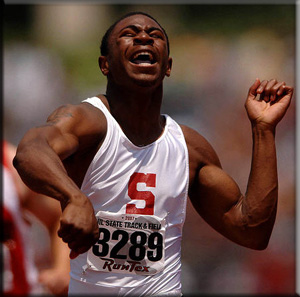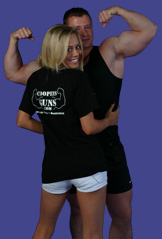Cardiovascular Exercise Explained
When your goals are adding mass and strength, it seems logical that cardio should be avoided since partaking regular bouts burns calories, calories which are essential in order for us to grow; however cardio has several benefits: it can help us stay lean, improve our fitness levels, and improve substrate utilization.
There’s so many conflicting opinions and a plethora of media misinformation it can all be a little confusing and de-motivating.
To help us gain a better understanding of what’s happening to our body when we exercise we must delve into some scientific jargon. Starting from the foundations we can talk about energy systems and muscle fibres.
The two main types of energy systems are known as Anaerobic and Aerobic. These energy systems are responsible for providing our muscles with the energy they need to work.
Anaerobic
Anaerobic simply means “without Oxygenâ€. This is a system, which generates energy (ATP - Adenosine Triphosphate) from non-oxidative sources.
Examples of anaerobic metabolic pathways:
- ATP - Creatine Phosphate
- Anaerobic Glycolysis
Think of this energy system as the 100m sprinter. When he sets off, his muscles use a small supply of readily available ATP (energy) to perform the fast explosive movements of his body. After a few seconds, this small supply of ATP has been depleted and his speed will begin to subside. Now his body has to use a small supply of Phosphocreatine (PC) stored in the muscle to regenerate the ATP he just used off. After about 15 seconds his Phosphocreatine levels are depleted and his muscles start to break down glycogen stored in the muscles and a by-product (lactate) is produced. After approximately 30 seconds he will have to slow down to jogging pace or stop altogether in order to recover.
Resistance training falls under this categorie. HIIT (High Intensity Interval Training) is a form of resistance training.

Aerobic
Aerobic simply means “with oxygenâ€. This is a system, which generates energy (ATP) from the consumption of Oxygen.
Examples of aerobic metabolic pathways:
- Aerobic Glycolysis
- The Krebs Cycle
To make it easier to understand these metabolic pathways try to imagine a marathon runner. Because his muscles are under much less demand they can generate the ATP from slower sources. A mixture of carbohydrate and fat is broken down and used to produce the ATP. The carbohydrate comes from glycogen stores inside the muscles (glycolysis) and the fat comes from fatty acids, which are broken down from fat stored in adipose tissue (lipolysis).
Endurance training falls under this catergorie. Steady State (SS) cardio is a form of Endurance training.

Anaerobic and aerobic energy systems are not entirely exclusive i.e. during anaerobic exercise to a lesser extent aerobic activity can also take place.
There is a common myth that exercising at 65% MHR (Maximum Heart Rate) is the “fat burning zone†however this is a blanket statement due to the fact that every individual is different and the ratio of carbohydrate:fat burned at different heart rates varies greatly. The only true way to find out which fuel you are burning is by measuring your respiratory exchange ratio (RER) through a series of gas analysis tests.
Muscle Fibres
Muscle fibres can help us to understand the benefits of training these energy systems. If you look at the properties of muscle fibres you can see which fibres are used more during resistance training and which fibres are used more during endurance training.
Our muscles are made up of three different types of fibres. The ratio of these fibres vary greatly from person to person i.e. one person might naturally be fast twitch dominant, where another might naturally be slow twitch dominant.
Type I – Slow Twitch [Oxidative] Properties:
- Low glycogen content
- High myoglobin content
- High mitochondrial volume
- Small motor neuron size
- Lowest force output
- Slow contractile speed
- Slow relaxation times
- High oxidative capacity
These fibres are recruited during endurance training
Type IIa – Fast twitch A [Oxidative-Glycolytic] Properties:
- High glycogen content
- High myoglobin content
- Medium mitochondrial volume
- Large motor neuron size
- High force output
- Fast contractile speed
- Fast relaxation times
- Medium oxidative capacity
These fibres are the middlemen – they can go either way
Type IIb – Fast twitch B [Glycolytic] Properties:
- Very high glycogen content
- Very high myoglobin content
- Low mitochondrial volume
- Largest motor neuron size
- Highest force output
- Very fast contractile speed
- Very fast relaxation times
- Low oxidative capacity
These fibres are recruited during resistance training
So to put this into perspective, if you’re a bodybuilder and you perform endurance training in order to burn fat, your hard earned fast twitch muscle fibres will begin to take the properties of slow twitch muscle fibres. This is one of the reasons why marathon runners are small and skinny whereas sprinters are usually big and muscular. Endurance training however does hold some advantages.
Advantages of Endurance Training
- Increased removal of metabolic waste products resulting in reduced DOMS (Delayed onset muscle soreness)
- Increased cardiac output and increased blood flow to tissue and more efficient nutrient delivery
- Reduced insulin levels increase insulin sensitivity after aerobic exercise, allowing for more efficient utilization of carbohydrates in restoring glycogen and stimulating protein synthesis
Advantages of Resistance Training
- Muscles change their composition to favour Type IIb Fast twitch fibres, which grow more easily than slow twitch fibres
- Burns a large amount of calories during the activity and while resting burns fat calories
- The EPOC (Excess Post-Exercise Oxygen Consumption) increases the metabolism for long periods of time after exercise. Oxygen is used to restore hormone balance, repair cells and anabolism. Fat stores are also used to replenish muscle glycogen levels
Important Points To Consider When Bodybuilding
- Due to the large amount of energy needed for resistance training, if the body has low glycogen stores due to a restricted calorie intake, the glucose needed is converted from amino acids in the liver into glucose via gluconeogenesis. This is very catabolic.
- The higher your heart rate the more calories you will burn. The higher your heart rate the more carbohydrate calories you will burn. The lower your heart rate the more fat calories you will burn.
- Cardio before a weights session depletes glycogen stores resulting in reduced performance during your training session, even more so in a calorie restricted diet
- Cardio after a weights session destroys the post-workout window of opportunity which is most influential on protein synthesis. It’s also highly catabolic
References
J. A. Simoneau, G. Lortie, M. R. Boulay, M. Marcotte, M. C. Thibault and C. Bouchard. Human skeletal muscle fiber type alteration with high-intensity intermittent training. Eur J Appl Physiol Occup Physiol. 1985;54(3):250-3.
R. Bahr, I. Ingnes, O. Vaage, O. M. Sejersted and E. A. Newsholme. Effect of duration of exercise on excess post exercise O2 consumption. J Appl Physiol 62: 485-490, 1987;
Steve Blades. MuscleTalk Pro-Member Rightyho. Altering Body Composition - Adding Muscle, Stripping Fat: Understanding your metabolism and how to manipulate it
J. I. Medbo and I. Tabata Relative importance of aerobic and anaerobic energy release during short-lasting exhausting bicycle exercise J Appl Physiol, Nov 1989; 67: 1881 - 1886.
Green, Simon; Dawson, Briant.; Goodman, Carmel; Carey, Michael F . Anaerobic ATP production and accumulated O2 deficit in cyclists. Medicine & Science in Sports & Exercise. 28(3):315-321, March 1996.
Perry, Christopher G.R. 1; Talanian, Jason L. 1; Heigenhauser, George J.F. 2; Spriet, Lawrence L. 1. Skeletal Muscle Metabolic Adaptations in Response to 6 Weeks of High-Intensity Interval Training. Medicine & Science in Sports & Exercise. 38(11) Suppl 1:S25, November 2006.
Ball, M.; Green, H.; Houston, M.. Muscle Fiber Composition And Fiber Type Metabolism During Prolongued Exercise. Medicine & Science in Sports & Exercise. 15(2):104, 1983.
Izquierdo M. Ibanez J. Hakkinen K. Kraemer WJ. Ruesta M. Gorostiaga EM. Maximal strength and power, muscle mass, endurance and serum hormones in weightlifters and road cyclists. J Sports Sci. 2004 May;22(5):465-78.
Shono N, Urata H, Saltin B, Mizuno M, Harada T, Shindo M, Effects of low intensity aerobic training on skeletal muscle capillary and blood lipoprotein profiles. J Atheroscler Thromb. 2002;9(1):78-85.

Very well written, extremely informative as usual. Could you please explain the following in more detail:
>Cardio after a weights session destroys the post-workout window of opportunity which is most >influential on protein synthesis. It’s also highly catabolic.
So according to this it is best to avoid cardio after a workout if you are looking to gain mass. Is that correct?
Also, I would like to see what you have to say on rowing. I would like to understand it’s benefits, the muscle groups it works etc. I am going to have a Google around but if any important points come to mind please let me know.
Keep up the great work.
Comment by Adam — September 10, 2007 @ 6:57 am
Rowing is fine, read the article about nutrient timing around workouts for more information about the post workout window.
cheers
Comment by Ste — October 1, 2007 @ 10:55 am
Hey i wasn’t sure where to ask this question whats the advatanges and disavantanges of doing more weights with less rep and more reps with less weight? Can u make an article Please?
Comment by Kevin — October 5, 2008 @ 3:15 am
Maybe I will write an article on this. For rep ranges it’s as follows:
1-3 Reps High Strength Gains
3-5 Reps High Strength Gains and Little Mass Gains
5-7 Reps High Strength Gains and High Mass Gains
7-10 Reps Less Strength Gains and High Mass Gains
10-15 Reps Low Strength Gains and High Mass Gains
15+ Is going into more endurance type fibres which arent good for adding mass
Comment by Ste — October 31, 2008 @ 8:47 pm
I’m a body builder and was just wondering if you wrote any conclusion about cardio and and gaining muscle mass. (Or maybe I’m just dumb and didn’t see it)
P.S. GREAT article, 10/10.
Comment by Adam — March 16, 2009 @ 4:29 am
Hi Adam,
The gist of it is that gaining muscle and improving cardio is possible but can be counter-productive if done in the same workout.
Comment by Phil — March 30, 2009 @ 5:15 pm
To All,
Please post comments and questions in the forums.
Site posts are rarely checked whereas forums posts are viewed daily.
Comment by Phil — March 30, 2009 @ 5:25 pm